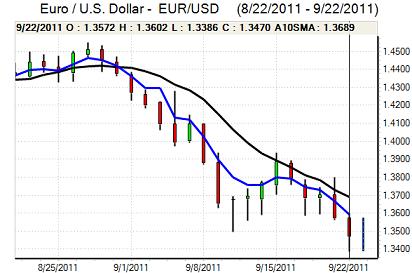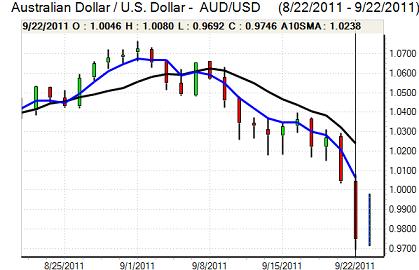EUR/USD
The Euro came under further pressure against the dollar on Thursday and retreated to lows near 1.3420, the lowest level since February during the New York session.
There was a further deterioration in sentiment toward the Euro-zone economy and financial sector as equity markets were subjected to further heavy selling pressure with a particular focus on the banking sector. There were persistent fears over the banks’ exposure to sovereign debts and there were also fears that European institutions will continue to lose access to credit lines.
There was a further deterioration in the Euro-zone PMI indices with the flash manufacturing index weakening to 48.4 for September from 49.0 previously while the services sector also weakened to below the 50 level for the first time in two years. There was increased speculation that the ECB would need to take emergency action to cut interest rates in an attempt to boost confidence.
There were also fears surrounding the global economy and fears over a renewed downturn as risk appetite also deteriorated. In this environment, there was an important flow of funds into the US currency, especially as emerging markets were subjected to heavy selling pressure.
The US economic data did not have a major impact as jobless claims fell to 423,000 in the latest week from 432,000 previously. There was a stronger than expected reading for house prices which may have some positive impact in confidence surrounding the housing sector, although the immediate impact is likely to be limited.
The Euro found support close to the 1.34 level and rallied back to above the 1.35 level as markets looked to correct from over-sold conditions.

Source: VantagePoint Intermarket Analysis Software
Call now and you will be provided with FREE recent forecasts
that are up to 86% accurate * 800-732-5407
If you would rather have the recent forecasts sent to you, please go here
Yen
The dollar was unable to make any impression on the yen during Thursday, although the dominant factor was that both currencies secured defensive inflows. The US currency was blocked in the 76.60 area and retreated to lows near 76.20 in Asia on Friday.
Underlying confidence in the global economy continued to deteriorate which triggered a flow of defensive flows into the Japanese currency. The weakness in equity markets and banking sector will be particular dangerous as there will be the threat of additional capital repatriation.
The Japanese authorities continues to promise decisive action to limit yen gains and the G20 meetings will be watched closely on Friday. There was also some speculation over additional policy initiatives over the weekend, although the authorities may struggle to secure a decisive response.
Sterling
Sterling was unable to regain the 1.55 level against the dollar during Thursday and came under further aggressive selling pressure with 12-month lows below 1.5350 despite the report interest of the Chinese central bank. The UK currency was undermined by the general deterioration in risk appetite as global equity markets were subjected to heavy selling pressure. A general lack of confidence in the banking sector also had an important negative impact on the UK currency.
There was further speculation that the Bank of England would move sanction additional quantitative easing, possibly as soon as the October MPC meeting. There was also speculation that there would be a shift in fiscal polices given the growth stresses.
The weaker outlook for domestic and global growth had an important negative impact on confidence with fears that the UK debt burden would quickly enter a vicious cycle again which could trigger a further downturn in economic activity.
The economic data provided no support with the CBI industrial orders index weakening to -9 for August from 1 previously. Markets stabilised slightly from late in the European session which allowed a rally back to the 1.54 area as sentiment remained very fragile.
Swiss franc
The Euro retreated from its best levels against the franc on Thursday as it was unable to hold above the 1.2280 area, but it was able to avoid substantial selling pressure. The dollar pushed to fresh 5-montyh highs around 0.9180 before retreating to the 0.9050 area in very volatile conditions.
The domestic ZEW data recorded a further deterioration to -75.7 for September from -71.4 previously, maintaining fears over the economic outlook and there was further pressure on the National Bank to maintain its aggressive policies and prevent renewed franc appreciation. The European banking sector remained a very important focus and there will be nervousness over the Swiss banking sector given its huge size relative to the Swiss economy.

Source: VantagePoint Intermarket Analysis Software
Call now and you will be provided with FREE recent forecasts
that are up to 86% accurate * 800-732-5407
If you would rather have the recent forecasts sent to you, please go here
Australian dollar
The Australian dollar was subjected to very heavy selling pressure on Thursday as sentiment deteriorated rapidly. There was stop-loss selling as the currency weakened through the parity level which increased selling pressure and selling pressure accelerated as equity markets were subjected to very heavy selling during the day.
Selling was compounded by increased fears surrounding the global economy which triggered further losses for commodity prices. As markets neared panic conditions, the Australian dollar weakened to 2011 lows just below the 0.97 level against the US dollar before a tentative recovery to the 0.98 area in Asian trading on Friday.



